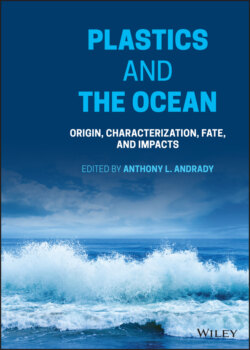Читать книгу Plastics and the Ocean - Группа авторов - Страница 58
2.5.2 Abiotic Samples
ОглавлениеWater and sediment are more frequently sampled than biota in plastic additive studies. For organic additives the sediment concentrations are routinely two to three orders of magnitude greater compared to that in water (Figure 2.5), as expected based on their log K ow or sediment water partition coefficients.
Monitoring surface water for additives is particularly well suited for assessing global spatial and temporal comparisons, because many plastic additives are soluble enough in water to be detectable by standard monitoring techniques. Also, seawater is a globally accessible sampling matrix that is regionally influenced by local point sources. By performing a meta‐analysis of phthalate concentrations in surface waters, Berge et al. (2013) reported that the European and Chinese coastal waters had higher median DEHP concentrations of approximately 1 μg/L, compared to North American waters (approximately 0.3 μg/L). However, an updated analysis of DEHP in marine waters only shows that the range of means in Asia are relatively higher than America, followed by Europe (Figure 2.6). The variability within each continental region, and the differences in sampling times, are too large to make definitive spatial comparisons. Berge et al. (2013) observed temporal trends in the phthalate concentrations in European fresh and seawaters, which were increasing until around 2000, then decreasing due to regulatory influence (Berge et al. 2013). The marine surface waters do not reflect this trend, but no studies before 2000 were included (Figure 2.6). Zhang et al. (2018b) found a vertical distribution of phthalates in seawater with greater concentrations at the surface of the ocean that decreased slightly with depth until increasing near the bottom.
Figure 2.5 Range of concentrations of three plastic additive classes measured in paired seawater and sediment samples. Note: Data were taken from de los Rios et al. (2012) for 4‐nonylphenol and bisphenol A in natural samples from the Bay of Biscay; and from Zhang et al. (2018b) for phthalates in Bohai and Yellow Seas.
Sediment cores can offer an in situ sample archive for environmental monitoring programs to signal when regulations were needed and also to track changes in pollutant levels resulting from regulations or societal shifts. Radionuclide dating is especially valuable in determining when different sediment layers with additives were deposited. Five studies have used sediment coring methods to understand temporal trends in plastic‐related chemical concentrations in Asian coastal waters only (Hashimoto et al. 2005; Moon et al. 2009; Peng et al. 2007; Wang et al. 2018; Zhang et al. 2013). Three of these studies focused on APs and/or BPA, revealing temporal trends that could be explained by local/regional land‐use or policy changes. Wang et al. (2018) observed increasing concentrations of plastic additive phenolic antioxidants, such as BHT, from the bottom to the top of cores collected close to the coast, indicating increasing temporal trends of these compounds in Chinese marine habitats. Zhang et al. (2013) explained complex periodic spikes in HBCDs measured in layers of a sediment core by China’s national economic development initiatives and the opening of a nearby corporation in 2005.
